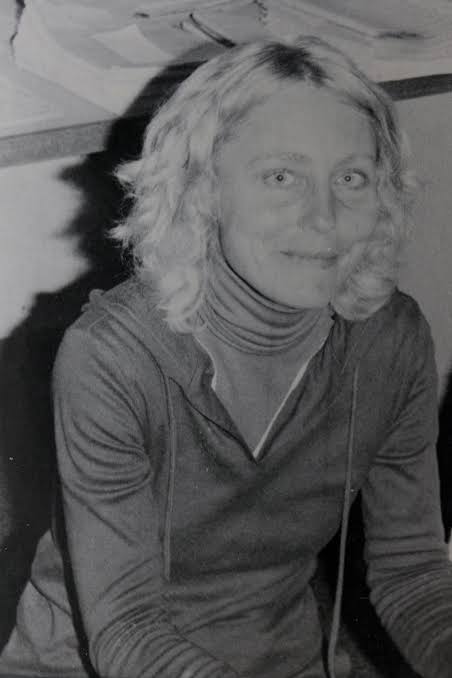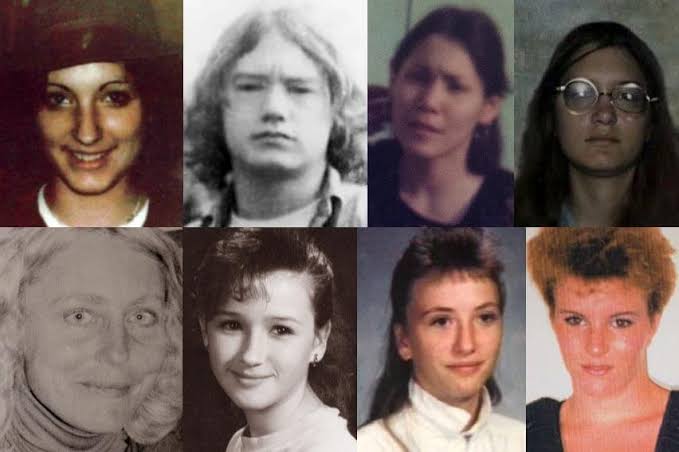
There is a stretch of road in Oregon that carries more than cars. It holds stories that once slipped between the trees unnoticed. Between 1977 and 1992, girls and women disappeared along this highway, some found too late, others not at all. Their stories now hang over Route 20 like a mist no one can clear. And one man kept showing up in all of them.
It began quietly in the spring of 1977.
The first known survivor
Marlene Gabrielsen was 20 years old and had just become a mother. She was still adjusting to life with a newborn when she and her husband drove to Sisters, Oregon, for the rodeo. A disagreement led him to leave with friends, and Marlene wanted to return home to Lebanon. She accepted a ride from a man driving a beat-up truck, just trying to get back to her baby. She noticed the inside of the truck seemed stripped down. There were no door handles. No cranks for the windows. Still, she got in.

She fell asleep. When she woke up, the truck had veered off Highway 20. The man pulled onto an old wagon road, stopped the truck, and held a knife to her throat. Then he dragged her into the woods, cut through her boots and underwear, and raped her. She pleaded with him, told him about her baby. For reasons she never understood, he agreed to drive her to her mother-in-law’s house.
Marlene went straight to the police. She saved the clothing. Her body was bruised. She insisted on a rape kit. The man she described was tall and heavy, probably worked outdoors. The police took her statement. They took the evidence. Then they let the man go.
That man was John Arthur Ackroyd. He worked for the Oregon Department of Transportation. He had access to remote stretches of road. He knew the places where the trees thinned out. And Marlene, as it would turn out, was just the beginning.

The Christmas runner who never came back
A year later, 35-year-old Kaye Turner and her husband traveled from Eugene to Camp Sherman, Oregon, to spend Christmas with friends. Kaye worked in public health. She was an athlete, a marathon runner, and a climber. On Christmas Eve morning, she went out for a jog before breakfast, around 8:15 a.m., planning to be gone for an hour. When she did not return by 10, her husband called the police.

One witness, a highway worker named Thomas Hanna, said he saw Kaye running. He also saw another highway worker nearby. That man was John Ackroyd. He claimed he was in the area to hunt coyotes and admitted to seeing a woman running alone. At the time, the police focused their attention on Kaye’s husband. They had discovered that Kaye had been having affairs with two men and considered the possibility of a domestic dispute.
Searchers found two sets of footprints in the snow. One matched Kaye’s Nike shoes. The other was from a large man’s boot. The tracks showed signs of a struggle and then a drag mark leading into the woods. For nearly eight months, nothing else turned up. Then in August 1979, Ackroyd returned to the police.
He told them he had found human remains while out in the woods. They were located about half a mile off the path Kaye had been running. There were scraps of clothing and bones. When questioned, Ackroyd explained he had seen the remains months earlier but had not reported them. He also revealed that he had picked up another man, Roger Dale Beck, and the two of them had been in the area at the same time.
Years passed. Then, in 1990, Ackroyd’s stepdaughter went missing, and police finally took a harder look. By 1992, both Ackroyd and Beck were indicted by a Jefferson County grand jury. In separate trials, both men were convicted of aggravated murder. The evidence had been fragile, and without Ackroyd’s own slip — reporting the remains — the case might have stayed unsolved. District Attorney Bill Hanlon later said, if Ackroyd had kept quiet, there would have been no case at all.
But there was another reason the case had reopened. Her name was Rachanda.
The girl in the woods with no one her age
Rachanda Pickle lived with her mother, Linda, and her stepfather John Ackroyd at Santiam Junction. The area was remote, a forested outpost where state road crews lived. There were no other children around. Rachanda was thirteen. She rode the bus to school. She stayed quiet. At home, Ackroyd abused her.

One day in 1990, Rachanda stayed home while her mother worked. Ackroyd was also home. At some point that day, she disappeared. A search party of over one hundred officers from seven counties fanned out across the area, but no trace of her was ever found. No body. No clothing. No witnesses.
By 1993, even as searches continued, authorities accepted that she was gone. Investigators kept compiling witness statements and records. In 2014, twenty-four years after she vanished, Ackroyd was charged with her murder. The prosecution entered a plea deal. Ackroyd agreed to plead no contest and promised never to seek parole.
The deal was structured so that he would die in prison, which he eventually did. For Rachanda, there would be no trial. No conviction. Only a quiet agreement that this man, who had lived beside her in the woods, was responsible.
But her story opened more doors. There were two other girls. A camping trip. A Shari’s restaurant. And another night where Highway 20 swallowed two more lives.
By the early 1990s, Highway 20 had a reputation that nobody spoke aloud. Between the coast and the quiet logging towns inland, girls had vanished. Families left porch lights on for years. Police tried to call each case a separate tragedy. But one investigator began seeing a pattern.
And it led back, again, to John Ackroyd.
The girls who left the campground
In the spring of 1992, two girls were camping with the Sanders family at Beverly Beach State Park on the Oregon coast. Sheila Swanson was nineteen. Melissa Sanders was seventeen. At some point during the trip, they grew bored and decided to hitchhike home. They were last seen leaving the campground in the middle of the night.
Their families thought they had left with friends. But when the girls did not return to Sweet Home, worry began to spread.
That same morning, Ackroyd showed up to work at the state highway shop in Sweet Home. His clothes were stained with blood. When asked, he said he had encountered a deer and had to gut it. When asked where the carcass was, he claimed he had thrown it in the brush along Highway 20. That was the stretch of road connecting the coast to the inland town where the girls lived.
Ackroyd had been a regular at the Shari’s restaurant where the girls often hung out. He had offered them a ride once before. He had even invited them to a party near Newport, not far from the campground where they had gone missing.
A few weeks later, local hunters found their bodies. They were off a logging spur near Highway 20. There were no signs that anyone had tried to hide the remains. No forensic evidence connected Ackroyd directly to the scene, but witnesses placed him near the area multiple times. He declined to be interviewed.
And this time, investigators started connecting the cases.

The pattern behind the disappearances
Ron Benson from the Lincoln County District Attorney’s Office and investigator Linda Snow reopened the 1992 case. Benson began lining up the details. Marlene Gabrielsen’s rape in 1977. Kaye Turner’s murder in 1978. Rachanda Pickle’s disappearance in 1990. Melissa and Sheila’s deaths in 1992. Benson found they had more in common than just a highway.
None of the bodies had been buried. Ackroyd had taken vacation days or time off during most of the crime windows. He often gave explanations tied to hunting or wildlife. He knew all the backroads. The patterns were not random.
By 2012, there was enough to prepare the case for a grand jury. But Ackroyd was already in prison, and the cost of prosecution would be high. The case was quietly closed. He was never charged for Melissa and Sheila.
Still, the story did not end there. More names had been whispered along Highway 20 for decades.
The ones no one could identify
In 1976, a moss hunter found skeletal remains of a woman near Swamp Mountain Road. The body was never identified. She became known as the Swamp Mountain Jane Doe. Investigators now suspect Ackroyd.
In May 1977, two teenagers vanished after hitchhiking. Rodney Grissom was fourteen. Karen Lee was fifteen. They called a friend from a payphone in Lebanon, Oregon, and said their ride had arrived. They were never heard from again. Later, some of their belongings turned up near Highway 20. Karen’s jeans appeared cut.
Also in 1977, Elizabeth Mussler disappeared from downtown Lebanon. Her bones were found the next year near Green Peter Reservoir, close to a Highway 20 exit.
That same year, the Cline Falls axe attack took place just ten miles north of Highway 20. Two young women were assaulted in their tent by a man with an axe. They survived. The case was never solved.
In 1978, three more sets of female remains were found. One woman was discovered near Thistle Creek, buried face down and believed to have been pregnant. Two other skulls were recovered from different wooded locations along or near Highway 20. All three women remain unidentified.
In 1986, forest workers found part of a skull and a few bones near Mount Hood. Decades later, thanks to DNA analysis, the victim was identified as Wanda Ann Herr, a nineteen-year-old from a group home in Gresham. When she vanished, no one filed a report. Her death was also linked to this same corridor of violence.
Each case was treated as a one-off. Each one had too little evidence. Each one had a backstory that investigators never fully opened. But the timeline and geography kept folding back on itself.
What the silence cost
Ackroyd never faced justice for most of the lives he took. He died in prison in 2013. By then, the Oregonian had started publishing a cold-case series on the disappearances. Reporters Noelle Crombie, Dave Killen, and Beth Nakamura called it The Ghosts of Highway 20. It was a title that carried weight. It was a name that stuck.
The team found what law enforcement missed for years. One man. One stretch of road. A cycle of violence that lasted nearly two decades. In every case, Ackroyd had an excuse. He was on his way to hunt. He had found the body by chance. He saw something suspicious but did not think it mattered. It always placed him close. Never quite close enough.
Marlene Gabrielsen, the first known survivor, lived to tell her story. She had spoken to the police. She had begged them to believe her. She preserved evidence. But her attacker walked free for years.
If they had listened to her in 1977, the highway might have stayed quiet.
But they did not. And the ghosts stayed.





